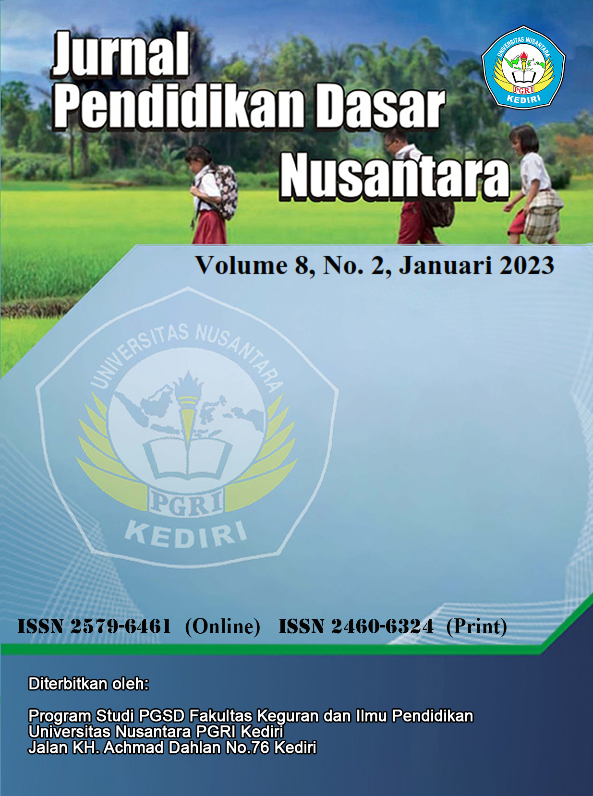Application of puberty animation media to improve student independence class VI elementary school
DOI:
https://doi.org/10.29407/jpdn.v8i2.17944Keywords:
Animated media, Puberty, IndependenceAbstract
The purpose of this research is to find out the application of puberty animation learning media in increasing the independence of class VI students at SDN 9 Purwodadi in 2021/2022. The research method used was classroom action research (PTK) with a total sample of 32. The data collection method used observation, tests, interviews, and documentation with the percentage results pre-cycle average achievement level of 44.32%, cycle I with an average achievement level of 48.7, and cycle II with an average achievement level of 79.36% had an increase. This is evidenced by the increasing percentage of the number of students independence in the process of teaching and learning activities before and after being given action
Downloads
References
Amaliyah, S., & Nuqul, F. L. (2017). Eksplorasi Persepsi Ibu tentang Pendidikan Seks untuk Anak. Psympathic : Jurnal Ilmiah Psikologi, 4(2), 157–166.
Arikunto, S. (2015). Prosedur-Prosedur Penelitian. Jakarta: Bumi.
Authon. (2016). HUBUNGAN DUKUNGAN SOSIAL TERHADAP KEMANDIRIAN ANAK YATIM YANG TINGGAL DI ASRAMA SMP ICMBS SIDOARJO. Skripsi, Fakultas Psikologi dan Kesehatan UIN Ampel, (August).
Dewi, D. M. (2016). Meningkatkan pengetahuan pendidikan seks melalui layanan informasi pada siswa kelas vi madrasah ibtidaiyah negeri sumurrejo kota semarang tahun ajaran 2015/2016.
Ellita Novianthy Baganu. (2017). Peran Orang Tua Dalam Memberikan Pendidikan Seks Terhadap Perilaku Seksual Remaja Di GKII Jemaat Tengkapak. Skripsi, S.Pd.K, Sekolah Tinggi Theologia Jaffray Makassar, 25–36. Retrieved from file:///C:/Users/ASUS/Downloads/Seks remaja.pdf
Fisher, T. D., Moore, Z. T., & Pittenger, M.-J. (2012). Sex on the Brain?: An Examination of Frequency of Sexual Cognitions as a Function of Gender, Erotophilia, and Social Desirability. The Journal of Sex Research, 49(1), 69–77. Taylor & Francis. Retrieved from https://doi.org/10.1080/00224499.2011.565429
Hasani, R.F., &, & Yusuf, E. A. (2020). The Influence of Religiosity on Premarital Sexual Behavior of Adolescents in Tanjungbalai. International Research Journal of Advanced Engineering and Science, 5(1), 52–53. Retrieved from http://irjaes.com/wp-content/uploads/2020/10/IRJAES-V5N1P22Y19.pdf
Hikmah, S. (2017). MENGANTISIPASI KEJAHATAN SEKSUAL TERHADAP ANAK MELALUI PEMBELAJARAN “AKU ANAK BERANI MELINDUNGI DIRI SENDIRI”: Studi di Yayasan al-Hikmah Grobogan. Sawwa: Jurnal Studi Gender, 12(2), 187.
Jalinus, N., & Ambiyar. (2016). Media dan Sumber Belajar. Jakarta : Kencana, 219.
Jannah, F. (2015). Inovasi pendidikan dalam rangka peningkatan kualitas pembelajaran melalui penelitian tindakan kelas. Prosiding Seminar Nasional PS2DMP UNLAM, 1(1), 27–32.
Kementerian Pemberdayaan Perempuan dan Perlindungan Anak (Kemen PPPA). (2020). Profil ANAK INDONESIA 2020. Pemberdayaan Perempuan dan Perlindungan Anak (PPPA), 84.
Kementerian Pemberdayaan Perempuan dan Perlindungan Anak (Kemen PPPA). (2021). PERATURAN MENTERI PEMBERDAYAAN PEREMPUAN DAN PERLINDUNGAN ANAK REPUBLIK INDONESIA NOMOR 2 TAHUN 2021. jdih.kemenpppa.go.id.
Komnas Perempuan. (2021). Perempuan Dalam Himpitan Pandemi: Lonjakan Kekerasan Siber, Perkawinan Anak, dan Keterbatasan Penanganan di Tengah Covid-19, Catatan Tahunan Kekerasan Terhadap Perempuan Tahun 2020. Catatan Tahunan Tentnag Kekerasan Seksual Terhadap Perempuan (Vol. 1). Retrieved from https://komnasperempuan.go.id/uploadedFiles/1466.1614933645.pdf
Laporan Perlindungan Saksi dan Korban (LPSK). (2020). Laporan Tahunan LPSK Tahun 2020. Retrieved from https://lpsk.go.id/publikasi/laporan
Margono, M. (2009). Tantangan Globalisasi terhadap Pendidikan Nilai Kebangsaan. Pendidikan Pancasila dan Kewarganegaraan Negara, 15(1).
Musfiqon, H. M. (2012). Pengembangan media dan sumber pembelajaran. Jakarta: PT. Prestasi Pustakaraya.
Prabowo, A. P. (2017). Sosialisasi Orangtua mengenai Pendidikan Seksual Pasca Pubertas pada Anak Tunagrahita. Jurnal Skripsi Universitas Airlangga Komunitas, 6 (1). pp. 60-81. ISSN 2303-1166, 6(1). Retrieved from http://repository.unair.ac.id/68204/1/Fis.S.31.17 . Pra.s - JURNAL.pdf
Sab’ngatun, Sri Suparti, T. W. A. (2019). PERILAKU IBU DALAM PENDIDIKAN SEKS PADA ANAK USIA 3-5 TAHUN. Avicenna Journal of Health Research, 2(1), 106–112.
Saydam, S. (2016). Kesadaran orangtua tentang kekerasan seksual pada anak usia dini di tk rawdah kids dernegi, istanbul turki.
Sugiyono, P. D. (2019). Metode Penelitian Pendidikan (Kuantitatif, Kualitatif, Kombinasi, R&d dan Penelitian Pendidikan). Metode Penelitian Pendidikan.
Sukarno. (2012). FUN AND EASY WITH MASTER IPA. PUSTAKA WIDYATAMA.
World Health Organization. (2016). Ending violence against children is priority. INSPIRE Seven Strategies for Ending Violence Against Children, 10–20. Retrieved from http://www.who.int/about/%5Cnhttp://apps.who.int/iris/bitstream/10665/207717/1/9789241565356-eng.pdf?ua=1
World Health Organization. (2020). World health statistics 2020: monitoring health for the SDGs, sustainable development goals (Vol. 2507).
Wulandari, R., & Suteja, J. (2019). Konseling Pendidikan Seks dalam Pencegahan Kekerasan Seksual Anak (KSA). Prophetic : Professional, Empathy and Islamic Counseling Journal, 2(1), 61.
Yafie, E. (2017). PENDIDIKAN SEKSUAL ANAK USIA DINI. Jurnal CARE ( Children Advisory Research and Education ), 4, 18–30.
Downloads
Published
Issue
Section
License
Authors who publish with this journal agree to the following terms:
- Copyright on any article is retained by the author(s).
- The author grants the journal, the right of first publication with the work simultaneously licensed under a Creative Commons Attribution License that allows others to share the work with an acknowledgment of the work’s authorship and initial publication in this journal.
- Authors are able to enter into separate, additional contractual arrangements for the non-exclusive distribution of the journal’s published version of the work (e.g., post it to an institutional repository or publish it in a book), with an acknowledgment of its initial publication in this journal.
- Authors are permitted and encouraged to post their work online (e.g., in institutional repositories or on their website) prior to and during the submission process, as it can lead to productive exchanges, as well as earlier and greater citation of published work.
- The article and any associated published material is distributed under the Creative Commons Attribution-ShareAlike 4.0 International License

































